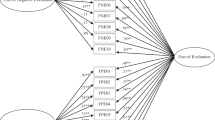Abstract
Analogue social-stress situations have assumed an important role in the assessment of social anxiety. However, psychophysiological assessment of social anxiety in these laboratory situations has produced inconsistent results. Notably, the empirical relationship between autonomic reactivity and behavioral indices of social anxiety has fluctuated widely. The present study examined the relationship between heart rate and behavioral ratings of social anxiety in a normal college-student sample utilizing a methodology which (a) addressed individual differences, (b) utilized a relatively unobtrusive heart-rate monitoring system, and (c) assessed time-lag relationships between the two measures. Cross-lagged correlations for the full sample of 25 subjects and a subset of heart-rate reactives showed large intersubject variability between the measures. The results support the lack of convergence between the two modes of measurement when subjects are considered as an aggregate.
Similar content being viewed by others
References
Abrams, D. B., and Wilson, G. T. Effects of alcohol on social anxiety in women: Cognitive versus physiological processes.Journal of Abnormal Psychology 1978,88 161–173.
Bellack, A. S. A critical appraisal for assessing social skills.Behavioral Assessment 1979,1 157–176.
Blanchard, E. B., and Young, L. D. Self-control of cardiac functioning: A promise as yet unfulfilled.Psychological Bulletin 1973,79(3), 145–146.
Borkovec, T. D. The effects of instructional suggestions and physiological cues on analogue fear.Behavior Therapy 1973a,4 185–192.
Borkovec, T. D. The role of expectancy and physiological feedback in fear research: A review with special reference to subject characteristics.Behavior Therapy 1973b,4 491–505.
Borkovec, T. D., Stone, N. M., O'Brien, G. T., and Kaloupek, D. G. Evaluation of a clinically relevant target behavior for analogue outcome research.Behavior Therapy 1974,5 503–513.
Curran, J. P. Skills training as an approach to the treatment of heterosexual-social anxiety: A review.Psychological Bulletin 1977,84 140–157.
Curran, J. P. Social skills: Methodological issues and future directions. In A. S. Bellack and M. Hersen (Eds.),Research and Practice in Social Skills Training. New York: Plenum, 1979.
Curran, J. P. A procedure for the assessment of social skills: The simulated social interaction test. In J. P. Curran and P. M. Monti (Eds.),Social skills training: A practical handbook for assessment and treatment. New York: Guilford Press, 1982.
Curran, J. P., and Gilbert, F. S. A test of the relative effectiveness of a systematic desensitization program and an interpersonal skill training program with date anxious subjects.Behavior Therapy 1975,6 510–521.
Davidson, R. J., and Schwartz, G. E. The psychology of relaxation and related states: A multi-process theory. In D. I. Mostofsky (Ed.),Behavior Control and Modification of Physiological Activity. New York: Prentice-Hall, 1976.
Dow, M. G., Craighead, W. E., and Borkovec, T. D.: Instructional demand and pretesting in the assessment of social anxiety.Behavior Therapy 1983,14(2), 326–332.
Eisler, R. M. The behavioral assessment of social skills. In M. Hersen and A. S. Bellack (Eds.),Behavioral assessment: A practical handbook. New York: Pergamon, 1976.
Epstein, S., and Roupenian, A. Heart rate and skin conductance during experimentally induced anxiety.Journal of Personality and Social Psychology 1970,16 20–28.
Gottman, J. M. Detecting cyclicity in social interaction.Psychological Bulletin 1979,86(2), 338–348.
Hersen, M., Bellack, A. S., and Turner, S. M. Assessment of assertiveness in female psychiatric patients: Motor and autonomic measures.Journal of Behavior Therapy and Experimental Psychiatry 1978,9 11–16.
Jennings, J. R., Berg, W. K., Hutcheson, J. S., Obrist, P., Porges, S., and Turpin, G. Publication guidelines for heart rate studies in man.Psychophysiology 1981,18(3), 226–231.
Johnson, L. C., and Lubin, A. On planning psychophysiological experiments. In N. Greenfield and R. Sternback (Eds.),Handbook of Psychophysiology. New York: Holt, Rinehart and Winston, 1972.
Kraemer, H. C., and Jacklin, C. N. Statistical analysis of dyadic social behavior.Psychological Bulletin 1979,86(2), 217–224.
Lawler, K. Cardiovascular and electrodermal response patterns in heart rate reactive individuals during psychological stress.Psychophysiology 1980,17 464–470.
Leelarthaepin, B., Coray, W., and Chesworth, E. Exersentry, C. An evaluation of its cardiac frequency monitoring accuracy.Australian Journal of Sports Science, 1980, (October), 1–11.
Porges, S. W., Bohner, R. E., Cheung, M. N., Drasgow, F., McCabe, P. M., and Kerch, G. New time-series statistic for detecting rhythmic cooccurrence in the frequency domain: The weighted coherence and its application to psychophysiological research.Psychological Bulletin 1980,88(3), 580–587.
Shipman, W. G., Heath, H. A., and Oken, D. Response specificity among muscular and autonomic variables.Archives of General Psychiatry 1970,23 269–374.
Twentyman, C. T., and McFall, R. M. Behavioral training of social skills in shy males.Journal of Consulting and Clinical Psychology 1975,43 384–395.
Twentyman, C. T., Boland, T., and McFall, R. M. Heterosocial avoidance in college males.Behavior Modifications 1981,5(4), 523–552.
Wallander, J. L., Conger, A. J., Mariotto, M. J., Curran, J. P., and Farrell, A. D. Comparability of selection instruments in studies of heterosexual-social problem behaviors.Behavior Therapy 1980,11 548–560.
Author information
Authors and Affiliations
Rights and permissions
About this article
Cite this article
Ahern, D.K., Wallander, J.L., Abrams, D.B. et al. Bimodal assessment in a stressful social encounter: Individual differences, lead-lag relationships, and response styles. Journal of Behavioral Assessment 5, 317–326 (1983). https://doi.org/10.1007/BF01321452
Accepted:
Issue Date:
DOI: https://doi.org/10.1007/BF01321452




